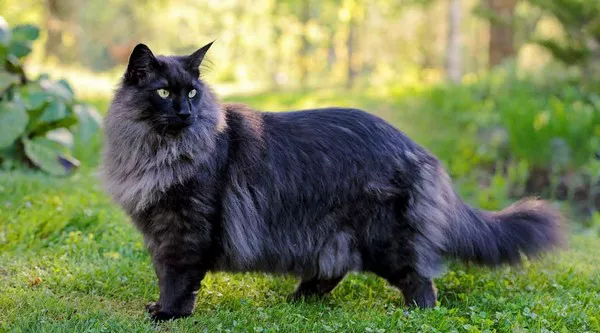The majestic Norwegian Forest Cat, with its tufted ears, bushy tail, and luxurious coat, is a breed that exudes elegance and charm. Known for their large size and robust build, these feline beauties have long been associated with a substantial physical presence. However, an intriguing question has emerged within the feline enthusiast community: Can Norwegian Forest Cats be small? In this comprehensive article, we will delve into the genetics, environmental factors, and potential variations within the breed to explore the possibility of smaller Norwegian Forest Cats.
Understanding the Standard
To comprehend the potential for smaller Norwegian Forest Cats, it is crucial to first establish a solid understanding of the breed standard. According to various cat breeding organizations such as The International Cat Association (TICA) and the Cat Fanciers’ Association (CFA), the Norwegian Forest Cat is generally described as a large, sturdy cat with a well-muscled body. These standards set the baseline for breed characteristics, emphasizing qualities such as a long, bushy tail, almond-shaped eyes, and a thick, water-resistant coat that adapts to the cat’s surroundings.
Genetics and Size Variation
One of the primary factors influencing the size of Norwegian Forest Cats is genetics. Cat breeding involves a complex interplay of genetic factors that dictate various physical traits, including size. Breeders selectively pair cats based on their desired characteristics, aiming to enhance specific features within the breed.
While the breed standard outlines the ideal size for Norwegian Forest Cats, it is essential to recognize that genetics can lead to variations within a litter. Just as in any population, there can be outliers – cats that do not conform strictly to the standard size. These size variations may be influenced by the combination of genes inherited from the parents.
It is plausible, therefore, for Norwegian Forest Cats to be smaller than the typical standard due to genetic factors. However, it is crucial to distinguish between naturally smaller cats and those that may be undersized due to health issues or improper breeding practices.
Health Considerations and Size
The health and well-being of a Norwegian Forest Cat play a pivotal role in determining its size. Cats that experience health issues during their development may exhibit stunted growth or fail to reach their genetically predetermined size. Common health concerns include nutritional deficiencies, parasitic infections, or underlying medical conditions that impede proper growth.
Responsible breeders prioritize the health of their cats, ensuring that they receive appropriate veterinary care, a balanced diet, and a nurturing environment. It is essential for potential cat owners to be aware of the significance of responsible breeding practices in maintaining the overall health and size of the Norwegian Forest Cat.
Environmental Factors and Size Variation
Beyond genetics and health considerations, environmental factors can also contribute to size variations among Norwegian Forest Cats. The environment in which a cat is raised, including the quality of nutrition, space for physical activity, and overall living conditions, can impact its growth and development.
Cats that have access to a well-balanced diet and ample opportunities for exercise are more likely to reach their full genetic potential in terms of size. Conversely, cats raised in suboptimal conditions may experience growth limitations. Therefore, it is crucial for cat owners to provide a nurturing environment that promotes the overall well-being of their Norwegian Forest Cats.
Selective Breeding for Size: Myth or Reality?
The concept of selectively breeding Norwegian Forest Cats for smaller sizes has sparked discussions within the breeding community. Some argue that selectively breeding for smaller cats may go against the traditional standards of the breed, potentially compromising the unique characteristics that define Norwegian Forest Cats.
However, proponents of selective breeding for size contend that it could lead to a more diverse population within the breed, accommodating the preferences and lifestyles of a broader range of cat enthusiasts. Striking a balance between preserving the breed’s essence and adapting to the preferences of potential owners remains a complex challenge for breeders.
See Also:Is My Cat Part Norwegian Forest Cat?
The Role of Ethics in Breeding
As discussions surrounding selective breeding for size unfold, ethical considerations come to the forefront. Responsible breeding encompasses more than just adhering to physical standards; it involves a commitment to the overall welfare of the animals. Breeders must prioritize the health, temperament, and well-being of Norwegian Forest Cats, ensuring that their practices align with ethical standards.
Ethical breeding practices emphasize transparency, honesty, and a commitment to continuous improvement. Breeders who prioritize these principles contribute to the overall betterment of the breed, fostering a community that values the highest standards of care for Norwegian Forest Cats, regardless of their size.
Conclusion: Embracing Diversity in Norwegian Forest Cats
In conclusion, the question of whether Norwegian Forest Cats can be small is met with a nuanced and multifaceted answer. While the breed standard outlines the typical size for these majestic cats, genetic variations, health considerations, environmental factors, and debates around selective breeding all contribute to the potential for smaller individuals within the breed.
Responsible breeding practices, guided by a commitment to ethics and the well-being of the cats, remain paramount in maintaining the integrity of the Norwegian Forest Cat breed. As the feline enthusiast community navigates the complexities of size variations, embracing diversity within the breed becomes a testament to the resilience and adaptability of these enchanting creatures.
In the end, whether large or small, each Norwegian Forest Cat is a unique and cherished individual, contributing to the rich tapestry of the feline world. By fostering a holistic understanding of size variations and promoting ethical breeding practices, we can ensure a bright and healthy future for this beloved breed.
Related Topics:
Do Norwegian Forest Cats like Water?
Do Norwegian Forest Cats Meow?
Do Norwegian Forest Cats Shed a Lot?



























